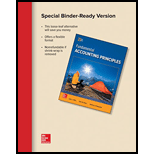
Requirement1:
First in First Out: The first in first out method of assigning the cost to goods sold is based on the principle that the goods that are entered first in the store room shall be issued first for sale and hence the cost shall be recorded at its initial prices of goods entered in store room. The periodic Inventory system means the records are maintained only at the end of period.
To determine: The Cost assigned to ending Inventory under FIFO.
Requirement2:
Last in First Out: The Last in first out method of assigning the cost to goods sold is based on the principle that the goods that are entered recently in the store room shall be issued first for sale and hence the cost shall be recorded at its recent prices of goods entered in store room. The periodic Inventory system means the records are maintained at the end of period.
To determine: The Cost assigned to ending Inventory under LIFO.
Requirement3:
Weighted Average: The Weighted Average method of issuing inventory is based on principle that the goods shall be issued at an average of prices of goods which are lying in the store room at the end of period. The periodic Inventory system means the records are maintained at the end of period.
To determine: The Cost assigned to ending Inventory under Weighted average.
Want to see the full answer?
Check out a sample textbook solution
Chapter 6 Solutions
Loose Leaf for Fundamental Accounting Principles
- Please explain the solution to this financial accounting problem with accurate principles.arrow_forwardI need help with this general accounting problem using proper accounting guidelines.arrow_forwardPlease explain the solution to this general accounting problem with accurate explanations.arrow_forward
- What is cedar solution net loss for the year ?arrow_forwardI need assistance with this financial accounting question using appropriate principles.arrow_forwardIn hedge accounting, a cash flow hedge affects: a. Current period income statement only b. Other comprehensive income until realized c. Balance sheet accounts only d. Retained earnings directlyarrow_forward
- What is the operating cycle?arrow_forwardIf Ryder Capital can give up one unit of future consumption and increase its current consumption by 0.94 units, what must be its real rate of interest?arrow_forwardI am searching for the most suitable approach to this financial accounting problem with valid standards.arrow_forward

 AccountingAccountingISBN:9781337272094Author:WARREN, Carl S., Reeve, James M., Duchac, Jonathan E.Publisher:Cengage Learning,
AccountingAccountingISBN:9781337272094Author:WARREN, Carl S., Reeve, James M., Duchac, Jonathan E.Publisher:Cengage Learning, Accounting Information SystemsAccountingISBN:9781337619202Author:Hall, James A.Publisher:Cengage Learning,
Accounting Information SystemsAccountingISBN:9781337619202Author:Hall, James A.Publisher:Cengage Learning, Horngren's Cost Accounting: A Managerial Emphasis...AccountingISBN:9780134475585Author:Srikant M. Datar, Madhav V. RajanPublisher:PEARSON
Horngren's Cost Accounting: A Managerial Emphasis...AccountingISBN:9780134475585Author:Srikant M. Datar, Madhav V. RajanPublisher:PEARSON Intermediate AccountingAccountingISBN:9781259722660Author:J. David Spiceland, Mark W. Nelson, Wayne M ThomasPublisher:McGraw-Hill Education
Intermediate AccountingAccountingISBN:9781259722660Author:J. David Spiceland, Mark W. Nelson, Wayne M ThomasPublisher:McGraw-Hill Education Financial and Managerial AccountingAccountingISBN:9781259726705Author:John J Wild, Ken W. Shaw, Barbara Chiappetta Fundamental Accounting PrinciplesPublisher:McGraw-Hill Education
Financial and Managerial AccountingAccountingISBN:9781259726705Author:John J Wild, Ken W. Shaw, Barbara Chiappetta Fundamental Accounting PrinciplesPublisher:McGraw-Hill Education





